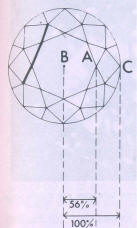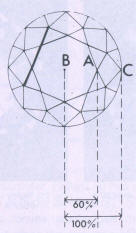The brilliant is observed under the microscope at a
chosen magnification at right-angles to the plane of the table. The
stone should not be tilted. As a check, the girdle, which lies in a
plane parallel to the table, should be sharply focused right round. One
of the eight table edges serves as the first reference line (A) (Fig
209). Parallel to it, through the centre of the stone runs one of the edges of
the eight pavilion girdle facets; it forms the second reference line
(B). Parallel to both these lines a third line (C) is, imagined as a
tangent touching the girdle at point X. First of all the line of the
table-edge A is taken as the only visible reference line and then the
distances AB and AC are compared with one another, so then. at a ratio
of 50: 50, the table size = 50 %.
Parallel to it, through the centre of the stone runs one of the edges of
the eight pavilion girdle facets; it forms the second reference line
(B). Parallel to both these lines a third line (C) is, imagined as a
tangent touching the girdle at point X. First of all the line of the
table-edge A is taken as the only visible reference line and then the
distances AB and AC are compared with one another, so then. at a ratio
of 50: 50, the table size = 50 %.
As this estimate starts from the table edge instead-of from a table
corner,
which lies further away from the centre than the edge, 4 % must be added
tc the result.
Thus the table size is actually 50 % + 4 % = 54 % of the girdle diameter.
 |
 |
| Fig 210 Measuring table in relation to visual estimation of the size of the table | |
From this observation further relatives values result:
AS : AC = table size 1 1/4: 1 = 60 %
1 1/2: 1 = 65 %
1 3/4: 1 = 69 %
2 :1=72%
| 54% 1:1 |
 |
| 60% 1¼:1 |
 |
| 65% 1½:1 |
 |
| 69% 1¾:1 |
 |
| 72% 2:1 |
 |
 |
 |
 |
| Table size = 54 % | Table size = 60 % | Table size = 66 % |
| Fig 211 The outline of the table alters With the size of the table | ||
 |
 |
 |
| Table size = 56 % | Table size = 60 % | Table size = 65 % |
| Fig 212 Table comparison method: The outline. of the table edge informs about approx. table size | ||
| Table diameter | Table comparison method |